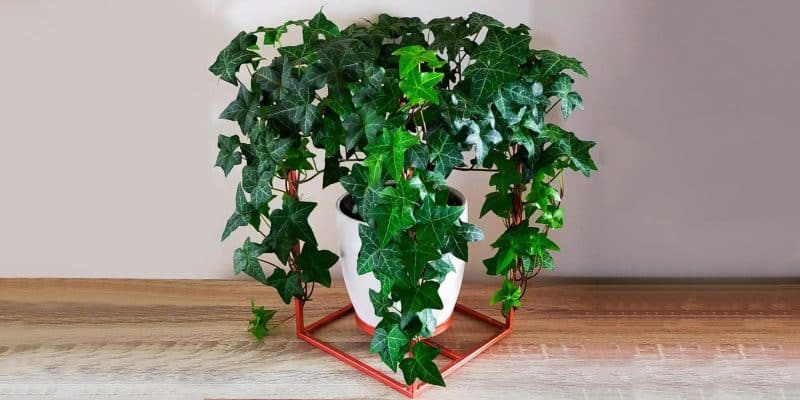Interested in growing English ivy indoors? You’re not the only one. English ivy is a timeless, instantly recognizable plant that can climb and trail, and doesn’t need much care to stay looking luscious.
While very hardy outside, English ivy takes a little bit more attention grown inside because it’s not a fan of drier air.
(Don’t worry — we’ll give you easy humidity tips!)
Plus, NASA identified this plant as an excellent air-purifier. What more could you ask for?
Let’s dive into English ivy care and how to make this plant your new indoor favorite!
Table of Contents
English Ivy Care Guide
History, habitat, and characteristics

English ivy, or Hedera helix, is also called European ivy, common ivy, or just plain ivy. From the Araliaceae family, English ivy is a species of evergreen perennial flowering plant native to much of Europe, West Asia, and North Africa.
Did you know: Colonial settlers originally brought English ivy plants to the United States — it’s first documented circa 1800 in Virginia.
Hedera is Latin for “ivy,” while helix is Greek for “spiral.” According to Lorraine Harrison in RHS Latin for Gardeners, the name fully translates to “the clinging plant that coils in spirals.” Pretty descriptive!
Classified as a liana (woody vine) variety, English ivy has a climbing habit, which means it uses aerial roots to climb up structures. These roots act like grappling hooks that can penetrate into the cracks and crevices of walls and other surfaces.
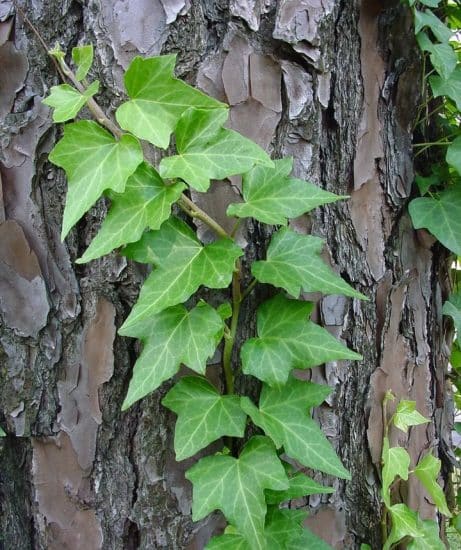
We should note here that in may countries, including the United States, English ivy grown outside is considered an invasive plant because it’s an aggressive grower with a tendency to choke out other outdoor plants in its path.
Fortunately, indoor ivy isn’t a problem — just be sure to dispose of any clippings carefully so you don’t accidentally start an outdoor ivy takeover!
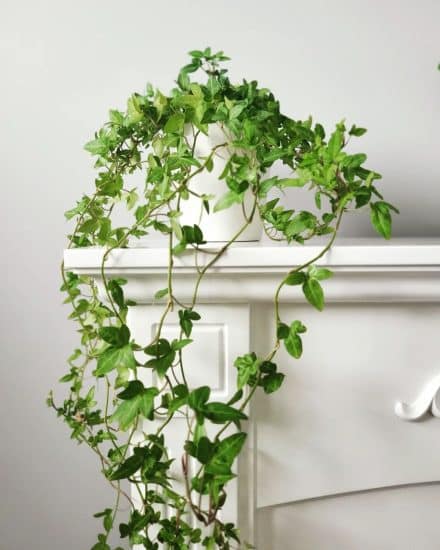
That being said, if you want to put a potted container of ivy outdoors in spring and fall, gradually acclimate it to the weather — add an hour of outside time each day. Bring it inside before the first frost or when temps go above 90 degrees F.
Depending on the cultivar, English ivy can reach heights of up to 18 feet in outdoor settings.
In terms of aesthetics, English ivy is incredibly versatile. This low-maintenance climber can be grown in free-standing containers or trailed from hanging baskets.
Most English ivy cultivars produce juvenile leaves with thee to five lobes and often scalloped or saw-toothed edges, but these leaves take on the familiar heart shape of their adult form as they age.
When grown outside, English ivy produces dark berries containing seeds, but they don’t do this as an indoor plant.
While the majority of the species showcases lush dark green foliage, there are multiple varieties available with more colorful markings on their leaves.
English Ivy Varieties
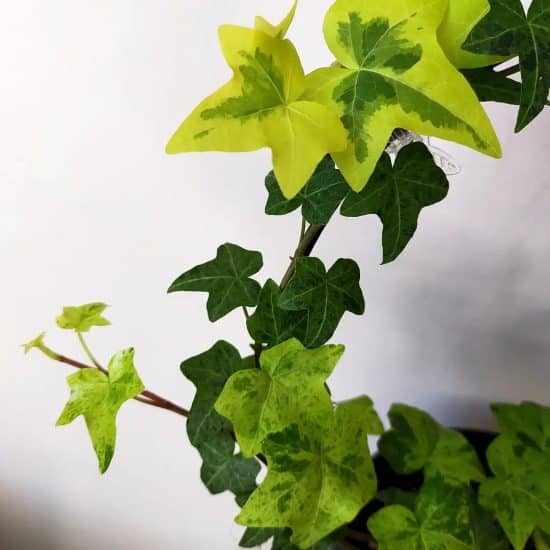
There are dozens of English ivy plants and cultivars, many of which have won the Royal Horticultural Society’s Award of Garden Merit. You can stick with tried and true green, or opt for more variegated ivy types like cream and yellow or green and white. Here are a few of our favorites:
Hedera helix ‘Duckfoot’ – leaves have bright yellow veins and are shaped like duck feet, with three lobes. Trails and doesn’t grow taller than 1.5 feet inside.
Hedera helix ‘Big Shot’ – leathery leaves mottled green and yellow that turn fully dark green when mature. A petite version that usually stays below 9 inches tall.
Hedera helix ‘Gold Child’ – leaves have 3 to 5 lobes, a grayish-green mottled center, and a margin of bright gold. Leaves are the biggest of all the gold-edged English ivy cultivars.
Hedera helix ‘Yellow Ripple’ – greenish-gray leaves with three to five points and yellow, creamy borders.
Hedera helix ‘Chester’ – green-grayish leaves with a white, creamy edges. Medium-sized leaves perfect for trailing vines.
Hedera helix ‘Emerald Jewel’ – bright green, glossy leaves with a triangular form, thin lobes, and heart-shaped base.
Hedera helix ‘Buttercup’ – bright yellow, glossy leaves that turn green with age.
Hedera helix ‘Glacier’ – small green-gray leaves with shallow lobes, silvery gray markings, and an irregular creamy margin.
Hedera helix ‘Anne Marie’ – medium-sized leaves, gray-green with creamy borders. Juvenile leaves have lobes, while adults turn diamond-shaped.
Hedera helix ‘Ivalace’ – curly ivy with glossy, dark green 5-lobed leaves and wavy edges, appearing almost lacy.

Light

English ivy plants need bright indirect light indoors to flourish. Remember, they’re less hardy inside the home than they are out. That means a north or east-facing window is ideal, since they both get weak light (north-facing gets indirect bright light all the time, and east-facing gets weak direct light in the morning and indirect light for the rest of the day).
You can put your plant near a southern or western exposure — just be sure to either move it a few feet back from the light source or dilute it with a sheer curtain or other, taller houseplants.
Did you know: Variegated ivy plants need more indirect bright light than solid ones and shouldn’t be exposed to direct sunlight (this could turn them completely green).
Too much light, and your plant might get yellow or brown with scorched, dry edges. Too little light, and it might go limp and sport pale white-green leaves. If your ivy isn’t getting enough light, you can supplement with artificial lights (we recommend LED over fluorescent to save on energy costs, and to give your plant a full spectrum of light).
Water
Watering your English ivy doesn’t need to be complicated. Not sure if your plant needs water? Check the soil beneath the surface with a finger — just an inch down should do. If it’s still moist, wait a few more days. If the soil is completely dry, it’s time for a drink.
During the growing season, don’t be afraid to let the soil dry out a bit between waterings. English ivy plants don’t like soggy, wet soil. If you’re not sure, err on the side of more dry than wet to avoid rotting roots.
Thoroughly drench the soil each you water, until water is coming out of the pot’s drainage holes. Empty the pot’s drainage or catchment tray after watering. And you don’t need to worry about getting the leaves on your plants wet, either.
English ivy plant actually enjoys water on its leaves — give it a bath with a spray of lukewarm water once a week to remove dirt, dust, and potential pests.
The amount of water your plant needs depends on several factors, including the plant’s size, light exposure, and temperature. During the warmer months, the plant may need more frequent watering, while in the winter, it will require less.
English ivy watering tips
- Use lukewarm water to avoid shocking your plant — think of it like a warm shower!
- Although tap water is fine for ivy plants, try to use filtered or even rainwater if possible. (You can also boil tap water beforehand to let chlorine evaporate, then let it cool to room temperature before watering).
- Too much water will result in wilting, yellowing leaves, and if there’s root rot, the pot might smell.
- Too little water could cause dull, faded leaves that are yellow, brown, and wilting, with brittle stems.
Temperature and humidity
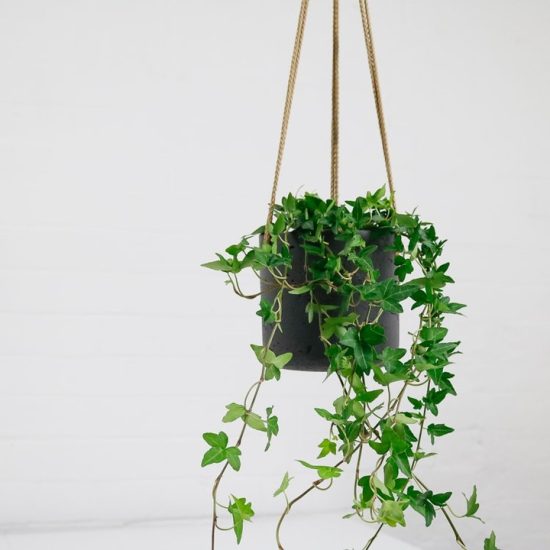
Taking a few simple steps to meet your English ivy plant’s temperature and humidity needs is the key to keeping your plant friend living its best, lushest life.
English ivy prefers temperatures between 50–70°F, slightly chillier that you might think. It isn’t a big fan of sudden temperature changes, so make sure to keep it away from drafty doors and windows!
While it likes drier soil, it really, really hates dry air. In fact, it likes to be in at least 40% humidity.
If you’re not sure if the range in your home is optimal, consider investing in a hygrometer to measure humidity and temp levels — they’re super cheap and really helpful!
If leaves start curling and looking yellowish-brown, your plant’s environment probably isn’t humid enough. To combat this, you can:
- Use a humidifier to add some moisture to the air
- Set up a pebble tray with rocks and water that can evaporate off to hydrate your ivy. Just remember, the base of the pot should never contact the water!
- Group your ivy close to other plants with similar moisture requirements so they can share humidity
Soil and planting

English ivy needs a well-draining soil to maintain its extensive root system and prevent rot/mildew.
Our recommended English ivy potting mix:
- 40% potting soil — provides structure, nutrients, and an anchor for the plant’s roots
- 40% sphagnum peat — has high organic content and helps make soil more porous (easier for roots to get nutrients and water)
- 20% perlite or horticultural sand — improves soil drainage and aeration
Optional: Consider adding a handful of horticultural charcoal, which helps absorb chemical impurities from the soil and mimics the plant’s natural environment in the wild.
Fertilizing English ivy is key for maximum health and growth. Use a 20:20:20 NPK liquid fertilizer at half strength twice a month during the spring and summer, with a break in fall and winter. Avoid over-fertilizing; too much fertilizer can burn the leaves.
Pruning English ivy

Prune your ivy when it’s looking unshapely or leggy. Wearing gloves to avoid potential irritation, snip the vine right above a leaf with clippers, or use your fingers (again, with gardening gloves still on) to pinch off the vine in the same spot.
Bonus: You can use the clippings to propagate! We’ll cover that in a bit.

Repotting English ivy
When your plant is slightly root-bound, it’s time repot. This will help the roots to easily slide out of the container, minimizing the chance of damaging them. Choose a pot or container with plenty of drainage holes only slightly larger than the current pot, so there is additional room for the plant’s roots to continue growing.
Propagation guide

Propagating English ivy is easy and doesn’t take long. While you can use seeds, the process is lengthy (think months), and since the plant doesn’t bloom indoors, seeds can be hard to come by.
Best to stick with stem cuttings!
You have two options here, stem cuttings in soil or water. If you use water, you can watch the roots grow, but the roots might have a slightly harder time adapting to soil when you switch up the medium. Totally your choice.
Propagating English ivy by stem cutting:
- Select stems that are 4-6 inches long and have several leaves. Trim off any leaves at the lower part of the stem — this is where your roots will form.
- If you’re using a jar of water, make sure the exposed stem nodes (bumps where new leaves emerge) are submerged in the water, and the remaining leaves are above the surface. If you’re using soil, you can optionally dip the cut end of the stem in rooting hormone, firmly press down the soil around it, and spritz the soil lightly with water.
- Cover the jar with a plastic bag and secure it with a rubber band to create a greenhouse-like environment. Place the cuttings in a spot where they’ll get indirect light and lots of it.
- If in water, change the water every week or so. If in soil, water regularly to keep it moist. In a few weeks, when roots reach about two inches long, you can plant the cuttings in soil and treat them as you would the mother plant, i.e., regular watering schedule.
And that’s it — you’ve mastered the art of propagating English ivy!
Common issues

Growing ivy indoors means dealing with the occasional brown tip or yellow spot. These are almost always watering or lighting issues, so they’re easy to fix.
Brown spots

If you notice brown spots on your English ivy paired with brown tips, it’s likely getting too much sunlight.
Solution: Move your plant farther back from any direct light sources or diffuse them with an opaque curtain.
If you notice brown, or dry foliage around edges, your plant is only getting indirect bright light already, and you’ve watered recently, your plant is getting too much water.
Solution: Remove it from its pot, plant it in fresh, dry soil, and don’t water for a few days. Wait until the soil is dry at least one inch down before watering in the future.
Finally, if you’re noticing brown spots, your plant is getting plenty of indirect light, isn’t overwatered, and hasn’t been fertilized recently, it might need more nitrogen.
Solution: Choose a fertilizer with a high nitrogen content and watch the problem clear right up.
Yellow spots

Yellow spots paired with crispy, curling leaves means your plant needs more water.
Solution: Water thoroughly until water drips out the pot’s drainage holes. Remove any standing water from the pot tray.
Faded yellow, droopy leaves means your English ivy isn’t getting enough light.
Solution: Move your plant closer to a bright indirect light source and watch its healthy hues return.
Diseases and pests

English ivy can become home to certain common pests or fungal diseases. To keep your ivy healthy and protected, keep an eye out for any signs or symptoms.
Root Rot
This is caused by overly wet soil in humid or wet conditions (read: overwatering!). To reduce the risk of rotting roots, check the moisture level of your soil before watering and allow it to dry out between waterings.
Solution: If you find black or brown, mushy roots, trim off any affected ones and repot in fresh soil and hold off on watering for a few days. In the future, make sure to water only when the soil is dry at least one inch down.
Fungal Diseases
Powdery mildew shows up as white, gray or yellow spots on your plant’s leaves.
Leaf spot can be either bacterial or fungal. Bacterial leaf spot, or Xanthomonas campestris, starts as light green wet spots that get larger and turn brown or black in the center. Leaf petioles and stems can also turn black.
Fungal leaf spot, or Colletotrichum trichellum, most commonly causes stem infection, leading the tips to turn dark and die. On leaves, it presents as large brown or tan spots, sometimes with black specks.
Solution: For both powdery mildew and leaf spot (both kinds), isolate the plant and spray with a fungicide.
Pests
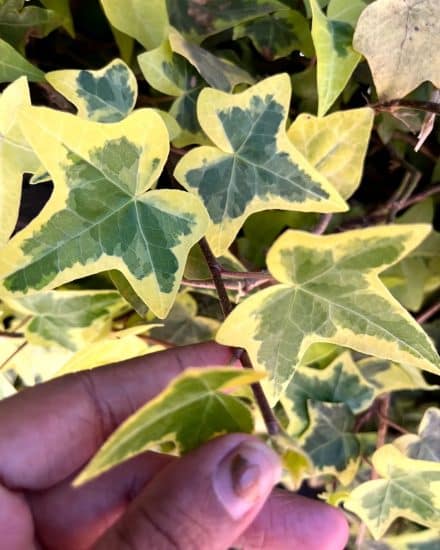
Aphids (small, pear-shaped, range in color), spider mites (small yellow or white spots, webbing on stems and the undersides of leaves), and mealybugs (tiny white masses) are some of the most common pests found on English ivy vines. These tiny bugs use their sucking and piercing mouthparts to feed on the sap of the plant, causing stunted growth and discoloration.
Solution: Isolate your plant so the problem doesn’t spread to others. Wipe down or spray your plant with a soapy water solution, then rinse it off. For more serious bug issues, grab a natural diluted neem oil, or even an insecticidal soap if necessary.
Conclusion

The perfect complement to any room, English ivy is (and has been) a plant for the ages. Whether you grow ivy indoors in a pot or let it trail from a hanging basket, it’s versatile and classic.
So take a deep breath and enjoy tending to the needs of your English Ivy — you’ll both be glad you did.
Let us know what variety you chose, or even send us a picture — we get as excited as you do!
FAQ
How much light does English Ivy need?
This plant prefers a medium light level, but always bright indirect, or at the most, very weak direct for part of the day.
How often should I water English Ivy?
Water your plant when the top inch or so of soil is dry to the touch. Watering more frequently could lead plant diseases or rotting roots.
Is English Ivy easy to take care of?
I’d say so, yes! Just remember not to overwater your indoor plants and to keep humidity levels high — indoor ivy doesn’t appreciate dry air.
Is English Ivy good for indoors?
Very. It’s an adaptable plant that can trail from a hanging basket or climb, and you can get varieties with different leaf sizes to suit your environment.
Can I keep English Ivy in my bedroom?
Why not? It even filters out harmful chemicals from the environment like trichloroethylene, xylene, and formaldehyde. Just make sure to open those curtains during the day!
Are English Ivy plants toxic?
According to the ASCPA, English ivy is toxic to animals, and it can also be a potential irritant to humans, so please wear gloves whenever you handle it.
Sources
- https://plants.ces.ncsu.edu/plants/hedera-helix/
- https://sophia.smith.edu/badseeds/ivycare.html#:~:text=Pest%20problems%20can%20be%20prevented,dirt%2C%20dust%2C%20and%20insects.
- https://www.missouribotanicalgarden.org/gardens-gardening/your-garden/help-for-the-home-gardener/advice-tips-resources/pests-and-problems/diseases/fungal-spots/leaf-spots-of-english-ivy#:~:text=Leaf%20spots%20on%20English%20ivy,active%20in%20causing%20stem%20infection
- https://ntrs.nasa.gov/api/citations/19930073077/downloads/19930073077.pdf
- https://www.fs.usda.gov/database/feis/plants/vine/hedhel/all.html
- https://www.aspca.org/pet-care/animal-poison-control/toxic-and-non-toxic-plants/english-ivy

